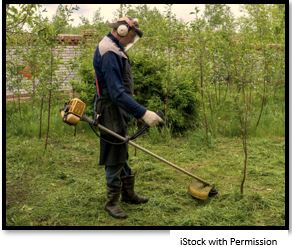
By Team Seaglass
Working outside, in professions like building maintenance and grounds management can be a rewarding career that allows you to create and maintain picturesque outdoor spaces. Whether you’re an amateur landscaper or a seasoned professional in the field, safety should be at the forefront of your mind. Working with tools, equipment, and natural elements demands careful attention to atmospheric conditions that can impact your safety. In this blog, we will explore essential tips and practices that ensure grounds-keeping maintenance safety allows you to cultivate both a secure and beautiful environment.
Protective Gear: Your First Line of Defense
Before embarking on any grounds-keeping maintenance task, don’t forget to gear up with appropriate protective equipment. Here are some essential items to include:
- Wear clothing suitable for the weather. Long pants and long sleeves will repel contact with insects or poisonous plants. Dress in layers to adapt to changing temperatures.
- Don’t forget sun protection. Wear a wide-brimmed hat and apply sunscreen to exposed skin.
- If you have known allergies or sensitivities, take appropriate precautions and carry any necessary medications (i.e. allergy medicine, EpiPen, etc.)
- Stay hydrated. Whether it’s cool or hot outside, physically active tasks can lead to dehydration. Always have an ample supply of water and take regular breaks to stay hydrated. And avoid caffeinated or sugary drinks.
- Wear personal protective equipment that protects you from flying objects:
- Safety glasses, goggles, &/or face shield
- Gloves that are sturdy, puncture resistant, and well-fitting
- Cut resistant chaps/sleeves when using cutting equipment
- Ear protection to protect hearing from loud equipment
- Steel-toed boots to protect against impact from heavy objects
Chemical Handling Procedures
Chemicals, such as fertilizers, herbicides, and pesticides are often used in landscape maintenance. Handle these substances with care:
- Read labels and follow instructions: Follow the manufacturer’s guidelines for storage, handling, and application of chemicals.
- Handle chemicals in well-ventilated areas. Wear respiratory protection as recommended in manufacturer’s instructions or Safety Data Sheets.
- Storage and disposal: Store chemicals in their original containers and keep them out of reach of children and pets. Follow Safety Data Sheet instructions for disposal.
Equipment Safety and Maintenance
Having the right tools and equipment is critical for both efficiency and safety. Consider the following:
- Check your equipment before each use to identify any damages or defects and repair before using
- Read the manuals. Familiarize yourself with the manufacturer’s instructions and safety guidelines
- Use tools and equipment according to their intended purpose
Be Aware of Surroundings
Be vigilant and mindful of your surroundings, as outdoor conditions can be unpredictable. Keep an eye out for:
- Uneven terrain, tree roots, equipment cords, or obstacles that may cause trip and falls
- Wildlife or insects that could pose a threat
- Poisonous plants, such as poison ivy or oak and know how to identify them
- Overhead hazards like low-handing branches and power lines
- Identify underground utilities before digging
- Include fall protection needs for job tasks involving work at heights
Safe Lifting and Carrying Techniques
Many outdoor jobs involve lifting and carrying heavy objects, like bags of mulch, landscaping stones, timber, and broken branches. To avoid muscle strain, consider these tips:
- If the object you’re lifting exceeds 50 lbs, then use a mechanical device or get help. The National Institute of Safety and Health (NIOSH) recommends adults not exceed a manual lift of 50 lbs.
- When lifting, use good body mechanics:
- Keep a wide base of support
- Squat down, bending at the knees
- Keep good posture
- Slowly lift the object using your knees…not bending at your back
- Hold the load close to your body
- Use your feet to move the load…don’t reach, twist, or bend forward when lowering the load
Communicate and Work in Teams
Working with others increases safety, as colleagues can help or alert you to potential dangers. Always communicate effectively, especially in noisy environments, and make sure everyone is on the same page regarding safety protocols. Buildings and Grounds-keeping maintenance are a “labor of love”, and by prioritizing safety, you can create and maintain beautiful outdoor spaces while protecting yourself and others from harm.


